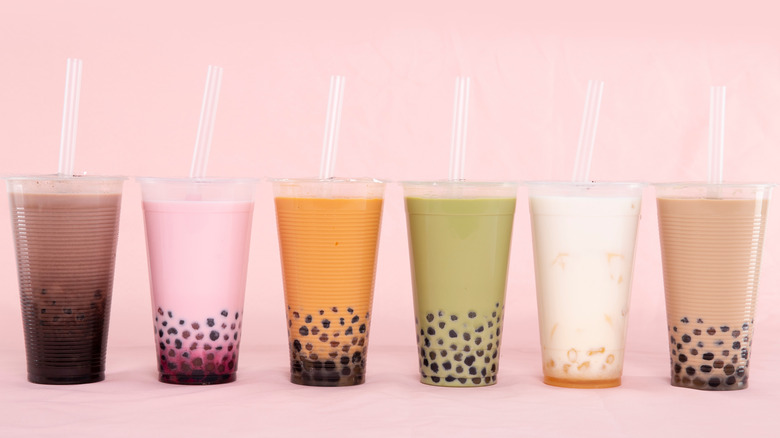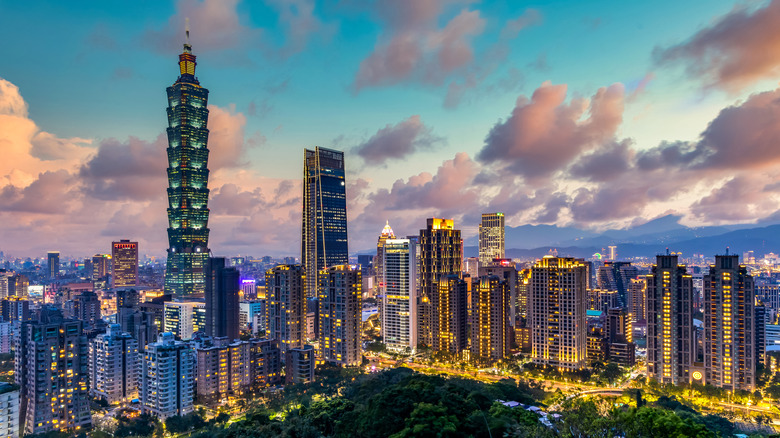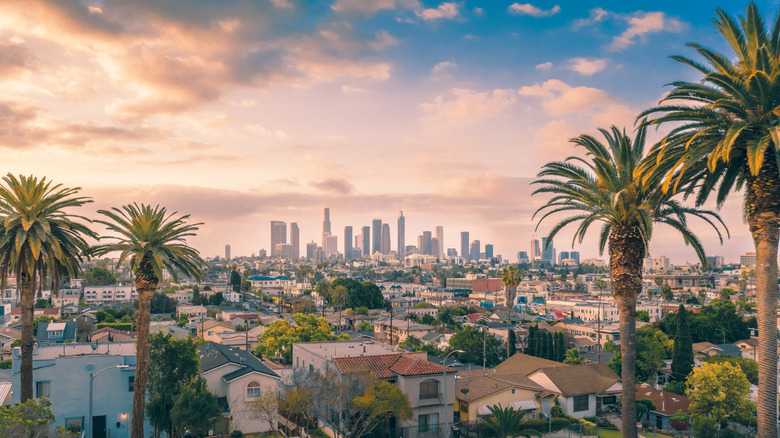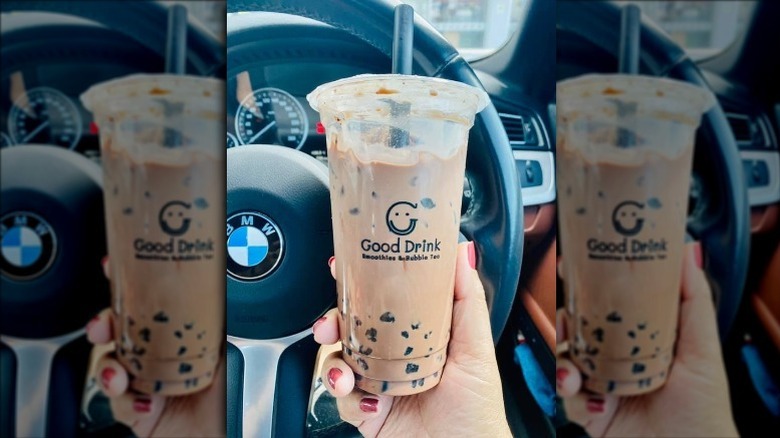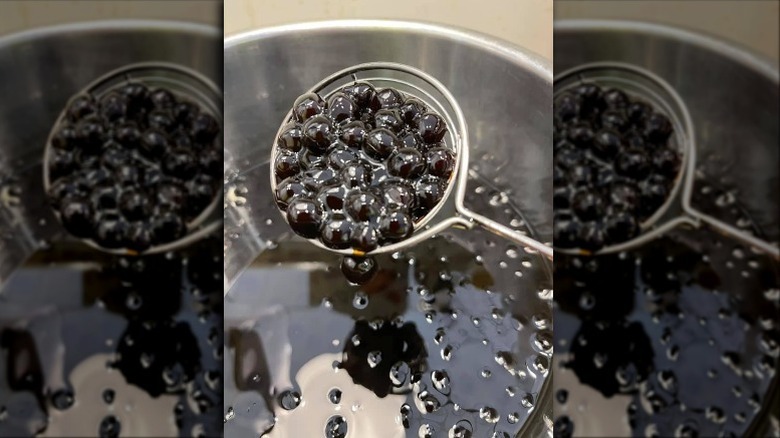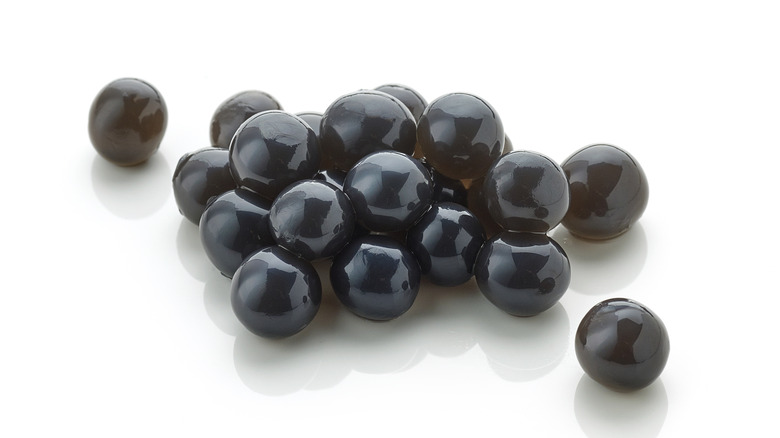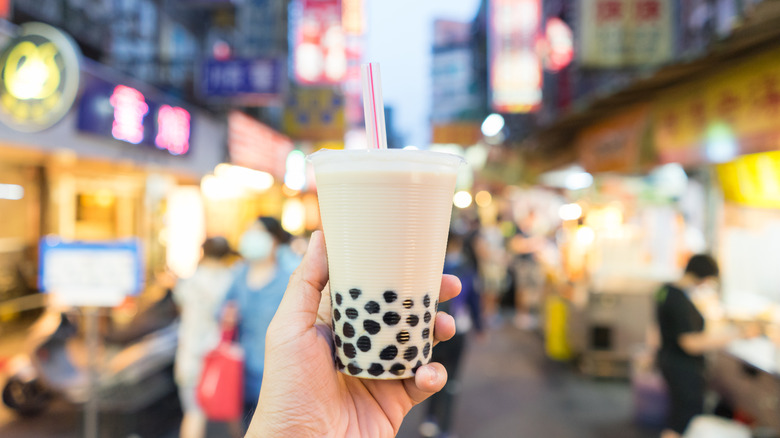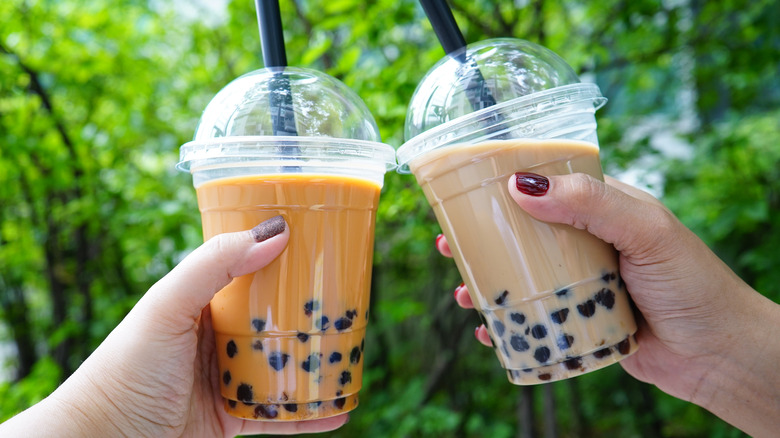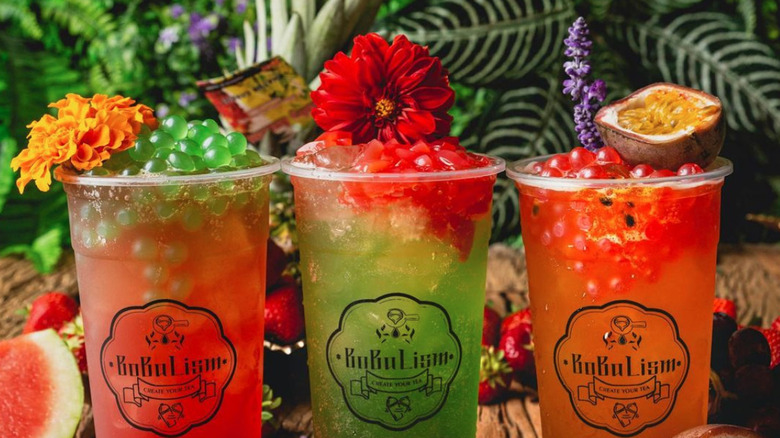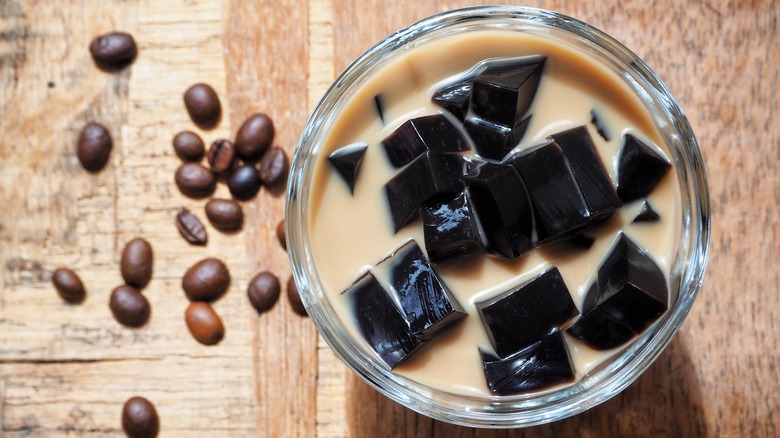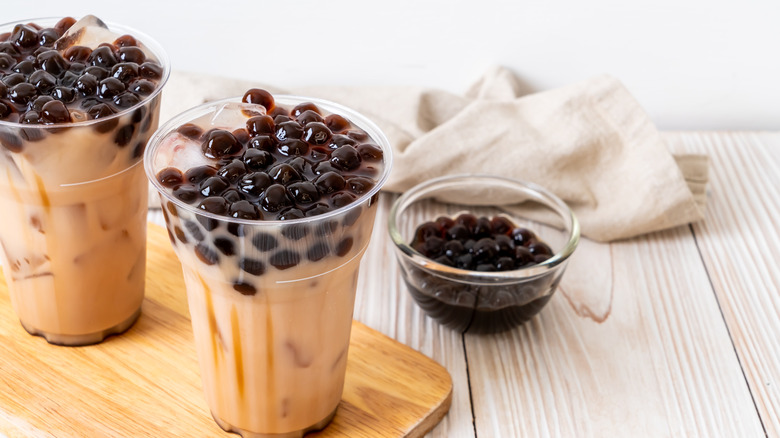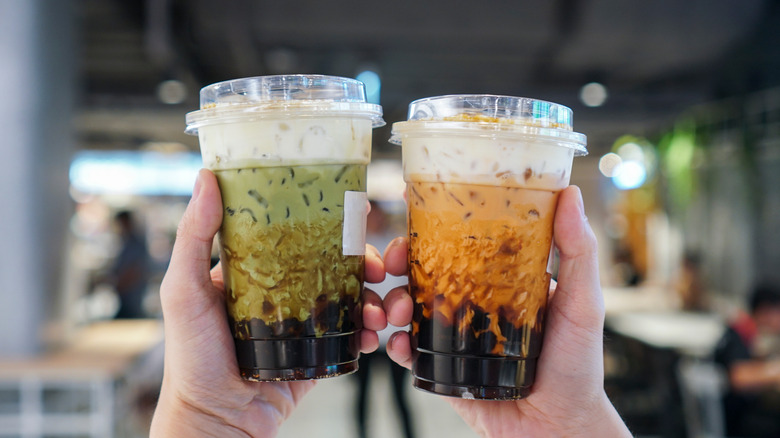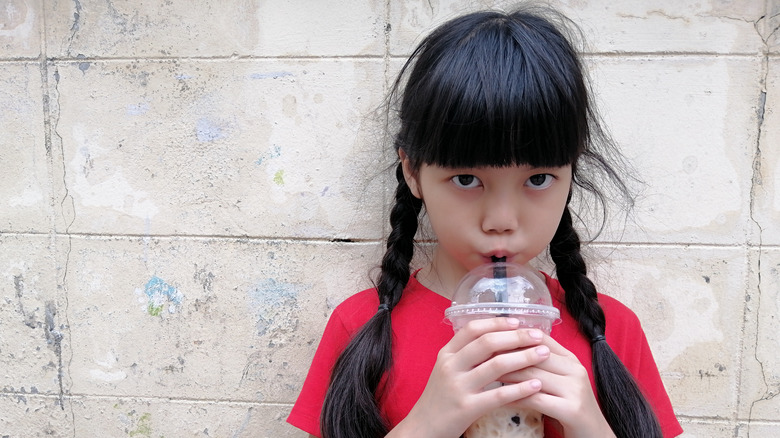The Untold Truth Of Bubble Tea
If there's any food that has gained an iconic, legendary status amongst Gen-Zers and younger millennials, it's bubble tea. Go visit any college town or young city neighborhood, and you're almost guaranteed to pass by a bubble tea place or two ... or three. It's tea, yes, but with a twist. This isn't grandma's cup of green tea in lieu of coffee in the morning. Instead, it's a mix between a drink and a dessert, an ideal midday pick-me-up. It has lots of different names but is mostly known by the monikers "bubble tea" or "boba," the latter of which is also used to describe the little balls at the bottom of your cup specifically (it's confusing, we know).
But whether you've tried it before or you've never touched the stuff and are just curious about it, we guarantee that there's a lot you don't know yet. The story behind this drink is an interesting one — and complicated at that — but it's good information to have if you plan to frequent a bubble tea shop any time soon. And with so many popping up all over the country, we can bet you're going to find yourself at one sooner than later.
That's why we've put our detective hats on and did some digging: so we can give you the intel on what bubble tea is all about. This is the untold truth of bubble tea.
It all got started in Taiwan in the '80s
Though bubble tea is exceedingly popular in the United States, it didn't start here. Rather, it all began in Taiwan in the 1980s. Its origins aren't completely clear, and different tea vendors claim to have created the beverage. According to Taipei Times, Hanlin Tea Rooms claims to have come up with the beverage back in 1986 when its owner was struck by sudden culinary inspiration. Another tea shop, Chun Shui Tang, says that an employee there invented bubble tea just a year later, in 1987. However, the truth remains unclear.
What we do know, though, is that milk tea, boba, and shaved ice were all popular desserts at the time of the drink's creation. According to Food and Wine, it occurred to someone to combine all of these desserts into one special drink. First, the boba went in the bottom of a cup. Then, shaved ice was layered on top. Add in the tea, and there you have it. Thus, bubble tea was born. (And we're so glad it was.)
It came to the U.S. via Asian immigrants in LA
The world is more global now than ever, so it's no surprise that a food created in Taiwan would make its way around the world to the U.S. However, bubble tea's meteoric rise to popularity raises some questions about how it became so popular so fast. Well, it seems that the popularity of the drink in the United States is largely due to Asian immigrants moving to Los Angeles. After Congress passed the Immigration and Nationality Act of 1965, it became illegal to bar Asians and other ethnic groups from immigrating to the United States. This brought waves of Asian immigrants to the U.S. in the decades that followed.
And where did many of those people go? You guessed it: LA. In fact, in 2008, LA boasted the largest number of Taiwanese immigrants of any city in the United States. While bubble tea was mostly concentrated in Taiwanese restaurants at first, by the turn of the millenia, bubble tea shops started popping up in standalone shops and food courts and gaining more widespread popularity (via LA Weekly). From LA, it started to sweep the rest of the country. These days, you can find bubble tea shops not just on the coasts but in the heart of middle America as well.
Classic milk tea is the most popular variety ... but there are many others
When you first go to a bubble tea shop, the first thing that you'll likely notice is the fact that there are so, so many options to choose from. It may seem daunting at first, but it doesn't have to be intimidating. If you're wondering what to get the first time you order bubble tea, you might want to stick with the classic milk tea. It's what first comes to mind for most people when they think of bubble tea, and it'll be available in pretty much any spot you visit.
Per Buzzfeed, it's the original bubble tea flavor, so you'll get a better idea of where the whole trend started. Apparently, it's also the most popular flavor. It involves a pretty basic concoction of ingredients: black tea, milk powder (nope — it's not liquid milk), and sugar.
However, there are tons of other flavors to choose from if you're feeling more adventurous. The light fruit teas are ideal for hot summer days, while the matcha green bubble tea is a perfect option for those who want to be a bit healthier. Don't forget to try taro tea and Thai tea for other amazing flavors. Moral of the story? Don't be afraid to try several different varieties of bubble tea — you never know what you'll like best until you taste it.
Boba is made from tapioca ... imported from Brazil
As you'll find out if you order bubble tea more than a few times, there are different types of boba (those little balls at the bottom of the cup) out there. However, the most popular and recognizable boba is made from tapioca and are referred to as tapioca pearls. If you order a classic milk tea, this is more than likely what you're going to be getting in your drink. And if you're wondering what tapioca is, you're not alone.
Tapioca starch, from which tapioca pearls are made, comes from the cassava plant. Cassava is from Brazil, and it's featured prominently in the country's culinary culture. So, how did it end up in Taiwan? The Japanese brought it to Southeast Asia during a period of occupation from the late 19th to mid-20th century (via Eater). From there, it worked its way up to Taiwan and into your cup of bubble tea. The story of this drink is a story of cultures and agricultural products mixing — and the food following suit.
The texture of boba is popular in Taiwan, but there's no English word for it
The first time you ever try bubble tea with boba in it, you may be surprised by the texture at first. Tapioca pearls have a kind of soft, springy chewiness to them — and that's exactly what makes the beverage so popular. However, if you aren't used to eating a lot of Eastern Asian food, this sensation may be unfamiliar to you. According to Roads and Kingdoms, in English, we don't have a word for this kind of food texture, but in Taiwan, it's known as Q or QQ. This texture known as Q is characterized by a rubbery bounciness that you just won't come across very often when you're eating most Western food, but it still has quite a bit of appeal in the U.S.
This texture isn't just a thing when it comes to boba, either. It's prominent in a ton of other foods you may have tried before, like fish balls, mochi, and many types of rice noodles. Therefore, if you like any of these foods, you're likely to enjoy tapioca pearls as well.
The "bubble" in bubble tea isn't referring to the boba
Looking at a cup of bubble tea, it seems really obvious where the term "bubble" comes from. At the bottom of the cup, it looks like there are dark little tapioca bubbles floating around. Or, at least, that seems to make sense. But in reality, that's not why it's called bubble tea at all. Instead, it has everything to do with the specific consistency of this drink. If you've ever gotten milky bubble tea and shaken it up before, you've probably noticed that it forms a kind of frothy foam on the top of the drink. That foam — and the bubbles it contains — is the namesake behind "bubble tea," according to Sous Chef.
However, you're not going to see these bubbles with every cup of bubble tea you drink. Most of the fruitier flavors aren't going to form those bubbles on top. Therefore, it makes sense that a lot of people would be confused about the origins of the term. Now you know the truth!
You won't believe what "boba" means in Chinese
Have you ever wondered about what the word "boba" actually means? If you're like a lot of people, you may not have thought about it. After all, outside of Taiwan, it's just come to mean the little tapioca pearls that you'll find at the bottom of your cup of bubble tea. But actually, the word has a totally different meaning in Chinese. According to Food and Wine, "boba" is slang for "breasts." This is in reference to the spherical shape of the pearls. That may be kind of a stretch, but we see where they're coming from.
However, now the word's meaning has changed to include the popular food item. These days, "boba" has taken on a new meaning inside China as well to include the adornments in this dessert drink as it gets more and more popular worldwide. But who would've thought such an innocent-seeming drink would have this kind of NSFW etymology?
The bubble tea craze in the U.S. was largely spurred by social media
These days, it's not unusual for social media to have its hand in just about every aspect of our rapidly changing lives. We should expect no different when it comes to food culture. Therefore, it shouldn't come as a surprise that social media is largely responsible for bubble tea becoming such a wide-reaching trend. In an interview with Today, founder of Bar Pa Tea in NYC said that though bubble tea had reached the United States by the '90s, it really took off in the mid-2000s due to the influence of social media.
This starts to make sense if you type "bubble tea" into pretty much any social network search bar. You'll be greeted with gorgeous drinks that are arguably more art than food. While the classic milk tea is appealing enough on its own, the more colorful and creative fruit flavors can look seriously impressive. Many bubble tea shops go over the top to create drinks that people will want to post on their social media feeds. In fact, many of these drinks are designed with aesthetics as a priority over actual taste.
So, yes, bubble tea is delicious, and people love how it tastes. But it has an aesthetic value beyond the flavor, and that's helped it thrive in the era of social media.
Tapioca pearls aren't the only toppings you can add to your drink
Considering that the terms "boba" and "bubble tea" are used interchangeably, you may assume that every bubble tea comes with the tapioca pearls sitting in the bottom. That, however, is not the case. While the tapioca pearls are the most recognizable "topping" you'll find at a bubble tea shop, that doesn't even begin to cover all the options available.
At Kung Fu Tea, a popular bubble tea chain, there are a long list of toppings to choose from. Customers can add pudding, nata jelly, red bean, herbal jelly, oolong jelly, and aloe jelly to their tea. These toppings all have unique textures that add different elements to a drink. There are also the popping bubbles, which have a flavored liquid inside as opposed to the more solid tapioca pearls. Popping bubbles also come in a wide range of flavors, meaning you can mix and match them depending on what kind of tea you're drinking.
And this is just one bubble tea spot — others have super-long lists of toppings. While the tapioca pearls do have that smooth, bouncy, chewy texture that people fall in love with bubble tea over, you should give other toppings a try if you really want to get a better sense of the drink in all its forms.
It's not exactly a healthy replacement for coffee or tea
For a lot of people, coffee and tea is a part of their daily routine. It's something to enjoy on the regular: first thing in the morning, as a middle-of-the-day pick-me-up, or even after dinner and drinks. But if you're thinking about replacing your everyday tea or coffee with bubble tea instead, we have some bad news: It's not really a great replacement when you take a look at the nutritional facts.
According to Health Digest, the drink isn't actually that good for you. More than anything, it's just a lot of sugar and carbs. And while those carbs and the caffeine from the tea can give you a boost of energy, you're probably better off health-wise with a plain tea or coffee. Bubble tea is generally also pretty high in calories, so if that's something you're watching, then regular bubble tea-drinking probably shouldn't be the plan. Obviously, though, this depends on the kind of boba you're drinking — fruitier bubble tea will have different nutritional stats than the milky stuff.
However, that doesn't mean that you should skip the boba altogether. Instead of thinking of it as a replacement for other caffeine-laden drinks that you enjoy throughout the day, think of it as a once-in-a-while treat instead. After all, it's basically just a dessert in drinkable form.
There were some (controversial) concerns about carcinogens in bubble tea
Back in 2011, a health scare rocked the bubble tea-loving world. According to the Taipei Times, there was concern about a compound that had been found in the syrups in bubble tea shops across the world. Instead of using palm oil, a typical ingredient in lots of processed foods, these syrups contained diethylhexyl-phthalate (DEHP), which is a compound often found in plastics that makes them more pliable. Doesn't exactly sound delicious, does it? It's more than just unappetizing, though: This compound is considered to be a carcinogen in rats. However, researchers are unaware if ingesting small amounts of diethylhexyl-phthalate (DEHP) causes problems for humans.
However, a year later, per The List, a separate report found no carcinogens in the additives used in bubble tea, and the original report was said to have damaged the bubble tea industry as a whole. It's unclear whether the first testing batch really was contaminated or not, but as of this writing, there's no clear evidence that you'll be ingesting carcinogens the next time you order a bubble tea.
Bubble tea's tapioca balls can be a choking hazard
The first time you try bubble tea, you'll notice that it comes with a larger-than-average straw. That straw is useful because it allows you to suck up all those delicious tapioca pearls or whatever other toppings you've chosen to add to your tea. However, use of this straw increases the risk that you could choke on your boba, especially if you're not being careful, per Mothership. This is especially careful the first time you try the drink, as you won't be used to the technique required to drink it. Just remember to take it slow — don't try to finish your whole cup in a matter of minutes.
Because of this choking hazard, it's also not a great idea to serve bubble tea to kids under the age of four, as they are more likely to choke on the boba than adults. However, considering that most parents don't want their kids drinking black tea, this shouldn't be too much of a problem to avoid for your little ones.
